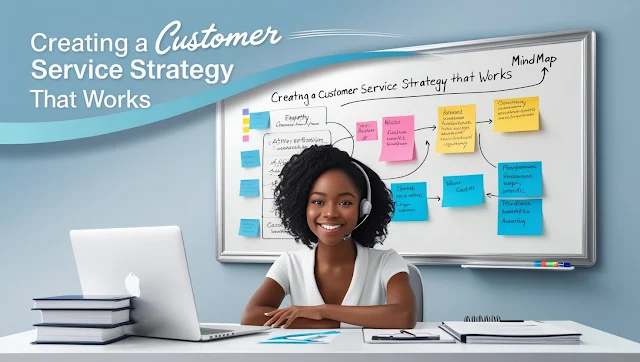A successful customer service strategy is key to building strong customer relationships, improving satisfaction, and driving long-term business success. Here’s how to create a customer service strategy that works:
1. Understand Your Customers
- Customer Personas: Develop detailed customer personas that represent your different customer segments. Understand their needs, preferences, and pain points.
- Customer Journey Mapping: Map out the entire customer journey, identifying all touchpoints where customers interact with your brand. This helps you understand their experience and areas where service can be improved.
2. Set Clear Service Goals
- Define Objectives: Determine what you want to achieve with your customer service, such as reducing response times, improving satisfaction scores, or increasing customer retention.
- Key Performance Indicators (KPIs): Set specific, measurable KPIs to track your progress. Examples include first response time, customer satisfaction (CSAT) score, Net Promoter Score (NPS), and resolution rate.
3. Train and Empower Your Team
- Comprehensive Training: Provide thorough training for your customer service team on your products, services, company values, and customer service best practices.
- Empowerment: Give your team the authority to make decisions, solve problems, and go the extra mile for customers without needing to escalate every issue to a supervisor.
- Soft Skills Development: Focus on developing soft skills like empathy, communication, and problem-solving, which are essential for delivering excellent customer service.
4. Implement Multi-Channel Support
- Offer Multiple Channels: Provide customer support across various channels, such as phone, email, live chat, social media, and in-person. This ensures customers can reach you in the way they prefer.
- Consistency Across Channels: Ensure a consistent experience across all channels. Customers should receive the same quality of service whether they contact you via phone, email, or social media.
5. Leverage Technology
- Customer Relationship Management (CRM) System: Implement a CRM system to track customer interactions, manage inquiries, and maintain detailed customer profiles. This helps in providing personalized service.
- Automated Tools: Use chatbots and automated responses to handle routine inquiries and provide immediate assistance outside of business hours.
- Knowledge Base: Create a self-service knowledge base or FAQ section on your website where customers can find answers to common questions.
6. Personalize the Customer Experience
- Personalized Interactions: Use customer data to personalize interactions. Address customers by name, reference their past interactions, and tailor solutions to their specific needs.
- Proactive Service: Anticipate customer needs and offer assistance before they have to ask for it. For example, if a product update is coming, notify customers in advance and provide relevant support.
7. Set and Communicate Clear Expectations
- Service Level Agreements (SLAs): Define SLAs that outline your commitment to response and resolution times. Communicate these expectations to customers so they know what to expect.
- Transparency: Be transparent about any issues, delays, or changes that might affect the customer experience. Customers appreciate honesty and clear communication.
8. Focus on Continuous Improvement
- Collect Customer Feedback: Regularly gather feedback from customers through surveys, reviews, and direct interactions. Use this feedback to identify areas for improvement.
- Analyze Metrics: Continuously monitor your customer service KPIs to identify trends, successes, and areas that need improvement. Use this data to refine your strategy.
- Employee Feedback: Encourage your customer service team to share insights and suggestions based on their interactions with customers. They often have valuable perspectives on what works and what doesn’t.
9. Handle Complaints Effectively
- Quick Resolution: Address complaints promptly and effectively. A swift and appropriate response can turn a negative experience into a positive one.
- Learn from Mistakes: Use customer complaints as a learning opportunity. Analyze the root causes of recurring issues and take steps to prevent them in the future.
- Follow-Up: After resolving a complaint, follow up with the customer to ensure they are satisfied with the solution and their overall experience.
10. Build a Customer-Centric Culture
- Leadership Commitment: Ensure that customer service is a priority at all levels of the organization, starting with leadership. Leaders should model a customer-first attitude.
- Incentives and Recognition: Recognize and reward employees who deliver exceptional customer service. This can motivate the entire team to strive for excellence.
- Customer-Centric Policies: Develop policies and procedures that prioritize customer needs and satisfaction. Make it easy for customers to do business with you.
11. Measure Success and Iterate
- Regular Reviews: Regularly review your customer service strategy and make adjustments based on performance data and feedback.
- Benchmarking: Compare your customer service performance against industry standards and competitors to identify areas for improvement.
- Innovation: Stay ahead by adopting new technologies, tools, and practices that can enhance your customer service.
12. Build Strong Customer Relationships
- Loyalty Programs: Implement loyalty programs or rewards for repeat customers. This encourages long-term relationships and repeat business.
- Community Engagement: Engage with your customers beyond transactions by building a community around your brand through social media, events, and content marketing.
- Personal Touches: Send personalized thank-you notes, follow-up emails, or small gifts to show appreciation for your customers’ business.
By implementing these strategies, you can create a customer service strategy that not only meets but exceeds customer expectations, leading to increased satisfaction, loyalty, and long-term business success.

Comments
Post a Comment